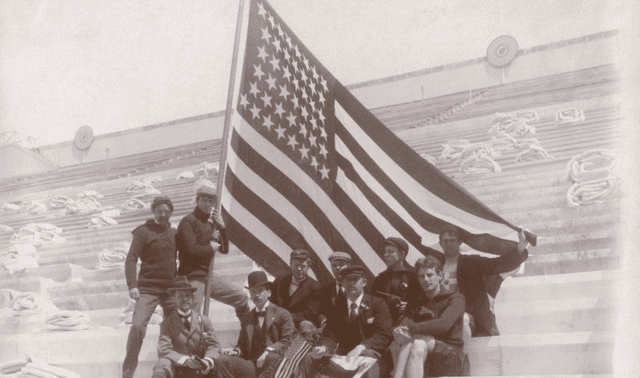When our ancestors needed to glue together broken shards of a pot or even do something as simple as connecting two pieces of paper, they relied on sticky substances from nature. Tar, beeswax, tree sap, egg whites, milk, decomposed animals, cheese and even blood were used for what turns out to be an essential human activity: sticking stuff together.
That all changed 100 years ago with the invention of phenol formaldehyde adhesives for plywood. Though little-heralded at the time, this breakthrough launched the modern adhesives age (as well as the plastics age—phenol formaldehyde would be put to use in Bakelite, the first synthetic plastic). In 1940, 95 percent of the raw materials in adhesives were still derived from natural sources. But by the 1980s, that figure had dropped to 35 percent as chemists custom-blended adhesives out of synthetic polymers.
The art of bonding, however, is ancient. Fishing tackle and arrows made around 8000 BC show evidence of glue. The 5,300-year-old “iceman” found in the Alps in 1991 possessed a yew-wood ax whose blade was attached with birch pitch. Babylonian artifacts were held together with collagen, an animal protein.
On the other side of the world, American Indians in eastern North America seamed birchbark canoes with a waterproof mixture of spruce gum and fat. The Yakutat Tlingit tribe of the Pacific Northwest combined burnt clamshells, salmon eggs, fish skins, seal brains and blood to make a waterproof (and no doubt odiferous) caulk.
Farther south, the Aztecs were using blood as an adhesive in construction as late as the 14th century.
Ancient Egyptians began gluing things in earnest by 1000 BC; surviving murals detail wood-gluing techniques. A casket from King Tut’s tomb and many museum pieces of Egyptian art and furniture were held together with animal glues.
In the first centuries AD, Greeks and Romans mastered the art of bonding thin layers of wood into veneers as well as the decorative art of marquetry. They used egg whites to make gold leaf stick and concocted glues from hide, milk, blood, bones, cheese, vegetables and grains. Romans caulked their ships with tar and beeswax.
Superior adhesives—their formulas lost to history—were key to Genghis Khan’s victories. Armed with bows made from laminated lemonwood and bullhorn, Khan’s men could fire arrows farther and more powerfully than their enemies.
Like so much of human discovery, the science of adhesives was set back during the Dark and Middle ages. Glue-making wasn’t revived until the 1500s, when it was primarily used in furniture. Antonio Stradivarius (1644-1737) also relied on an adhesive process—which modern science has been unable to re-create—to laminate specially treated woods for his famous violins.
The growing popularity of adhesives in manufacturing led to the establishment of the first commercial glue factory, which used animal hides, about 1700 in the Netherlands. The first adhesive patent was issued for a fish glue about 1750 in England. Paper products also began to get glued. The first lick-and-stick stamp used by a postal service was the Penny Black, issued by the United Kingdom in May 1840.
The development of cellulose—originally to replace the ivory in billiard balls—and Bakelite ushered in the era of plastics and synthetic materials, which revolutionized the science of stickiness. As one industrial history puts it, “Although adhesives have been known for about 6,000 years, most of the technology of adhesives has been developed during the last 100 years.” That’s when we began to shed such homely ingredients as fish glue and paste derived from vegetable starches in favor of chemical creations such as phenol formaldehyde (1910), polyvinyl acetate (1920) for gluing wood, epoxy (1930), cyanoacrylate (1942) and polyquinoxaline (1960).
New uses accompanied the new adhesives. In 1920, Band-Aid introduced its first adhesive bandage. Made by hand and measuring three inches wide by 18 inches long, the bandages were a flop; the company sold only $3,000 worth in the first year. By 1942, however, smaller and easier-to-use Band-Aids were shipped overseas by the millions as part of the war effort. Plastic-strip bandages, introduced in 1951, made Band-Aid a household name.
Masking tape, invented by Richard Drew in 1925, launched a whole industry for the Minnesota Mining and Manufacturing Co. (3M)—but it almost didn’t happen. At the time, the company was focused on sandpaper. Drew visited an auto body shop in St. Paul, Minn., to test a new batch of sandpaper, and observed the tribulations of a crew painting then-popular two-tone cars. When the workers removed the tape and butcher paper used to mask parts of the car while painting, much of the fresh paint came off, too.
Drew went back to his lab and experimented with backings and adhesives for masking tape, until the company president told him to quit fooling around and get back to sandpaper. Undeterred, Drew kept at it, financing the tape project by writing a series of $99 purchase orders—since he was authorized to make purchases under $100 only.
Early 3M tape took a similarly thrifty approach, with adhesive applied only along the edges, which caused the tape to fall off. One annoyed customer told Drew to “take this tape back to those Scotch bosses of yours and tell them to put more adhesive on it”—and thus “Scotch Tape” was born.
Drew struck again in 1930, when he came up with a way to coat cellophane with adhesive. Sales of the transparent tape were sluggish, though, until John A. Borden came up with a dispenser with a built-in cutter in 1932.
Many great adhesive discoveries were serendipitous. In 1942, Eastman Kodak researcher Harry Coover, seeking a way to make clear plastic gunsights, created cyanoacrylate, which stuck to everything. Nine years later, Coover and Fred Joyner “rediscovered” the compound, which was ultimately marketed as Super Glue.
Similarly, 3M scientist Spencer Silver invented an easily removable adhesive in 1968, but it was his colleague Art Fry who came up with a practical use. While singing in his church choir, Fry kept losing the bookmarks he’d inserted in his hymnal. The solution, Post-it Notes, hit the national market in 1980.
Among the latest innovations in adhesives is gluing people back together: Surgical glue, introduced on the battlefield in Vietnam using a variety of Coover’s cyanoacrylate, was approved for US medical use in 1998.
Fun fact: Super Glue was famously demonstrated by its inventor, Harry Coover, on TV in 1959. He used a single drop placed between two steel cylinders to lift “I’ve Got a Secret” host Garry Moore off the ground.
Fun fact: Duct tape was originally Army green and commonly called “duck” tape because it repelled water. After WWII, the tape was changed to gray to match the duct work in postwar housing.
Fun fact: The cow on Elmer’s glue bottles is actually Elsie, the “spouse” of the company’s namesake bull.
Timeline
1750 First glue patent is issued in Britain
1848 Henry Day invents adhesive tape
1882 German pharmacist makes the first adhesive bandage
1910 Phenol formaldehyde is invented
1925 Richard Drew invents masking tape
1930 … and cellophane tape
1935 R. Stanton Avery makes self-adhesive labels
1940 Procter & Gamble packaging engineer invents “hot glue”
1942 Johnson & Johnson sells duct tape
1958 Super Glue debuts
1966 Surgical glue tested in Vietnam
1978 3M blankets Boise with Post-it Notes to test reaction
From the November 2010 issue of Family Tree Magazine.
More great genealogy resources from Family Tree Magazine:




